Hunting Early Season Geese
By Seth Steinhauer
Wisconsin’s early goose season gives hunters the first shot at birds that haven’t been pressured in over seven months, along with young geese who have never been pursued by hunters. This does not suggest that early season geese are “dumb” by any means. There are, however, certain tricks that can be used early season that won’t usually work on heavily pressured birds. By paying close attention to shooting equipment, concealment, decoy placement, motion, and vocalization, you can greatly increase your chances at filling an early season limit.
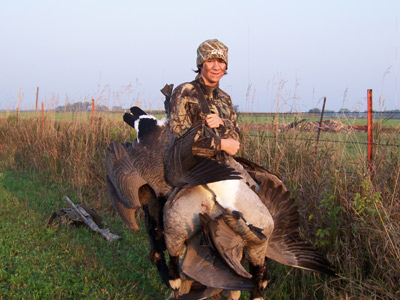 |
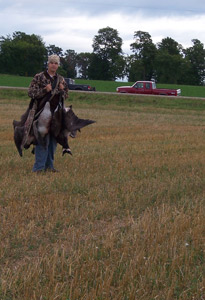 |
| Graham Steinhauer holds a limit of geese near Stevens Point Wisconsin. The crew of hunters used a field row for concealment. | Wheat fields usually produce the most consistent early season action. |
During the early season, shots at geese are generally going to be at close range over decoys. Also keep in mind that early season birds haven’t grown their thick winter plumage and are often lacking thick skin and fat. This allows you to use more open chokes and smaller shot size than you would later in the season. Start with an improved cylinder choke and steel twos. This is usually a perfect combination for knocking down early season birds out to 30 yards.
Try to pick out light, breathable camouflage clothing with more green than brown or yellow incorporated into the pattern. Always wear face paint or a face mask, and make sure to cover your hands with gloves or paint. Nothing sticks out more against a green backdrop than a pasty white face and set of meat hooks.
Once you have located a field in which geese are consistently feeding, look carefully at the field and its surroundings. Often times early season hunters can take advantage of heavily vegetated field rows or standing crops in which to hide. As birds become more pressured they tend to shy away from any type of cover that may conceal a hunter, but during the early season birds will usually approach a field low and without much hesitation making these spots perfect ambush points. If your field fails to provide a natural hiding spot, layout blinds may be your best option.
When laying out your decoy spread, try to imitate exactly how the live birds were spread throughout the field. Early season geese usually hang out in loosely concentrated family groups of eight to twelve. Start with three or four groups of decoys, adding more if needed. The groups should be placed 15 to 30 feet apart, while the decoys within the groups should be spaced one to two feet apart. There should be no need for more than two or three dozen decoys. Silhouette decoys tend to work just fine for early season geese, with the majority of the body styles being feeders with a few sentry or “lookers” added to each group.
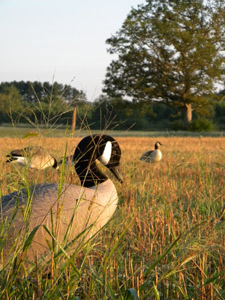 |
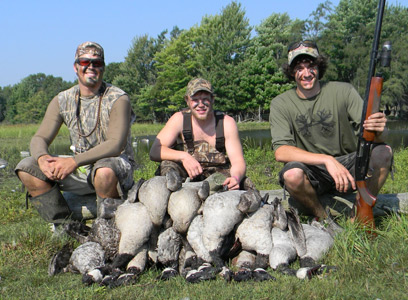 |
| The result of many long hours of scouting. We found this field after getting lost during a rainstorm and traveling 30 miles in the wrong direction. | Wheat fields seem to provide the most potential for early season goose hunting. |
It is also a good idea to add some motion to your decoy spread using flags. Flags will grab the bird’s attention from a distance and can be used to draw the geese directly to your landing zone on the final approach. Flag vigorously when you first see geese on the horizon until they begin heading your direction. Once they are heading your way, only flag if the geese look as if they are going to land shy of your landing zone. When geese are close, simply twitch the flag a few times, moving it just enough to get the birds attention. Over flagging geese at close range is a big no-no and will often flare the entire flock.
Calling geese during the early season is not usually necessary. Early season birds are often completely mute for long periods of time. They do, however, become somewhat vocal when a new flock of birds is approaching the field. Use trial and error to determine what works by only using soft clucks and moans at first. If the birds seem to respond well to the call, keep on keeping on. If the birds are landing short or flaring off of your spread, try no calling, and if that doesn’t work try some aggressive clucks, honks, and feeding moans. Determining what the birds want to hear is often a day to day battle that can only be won by experimentation and experience.
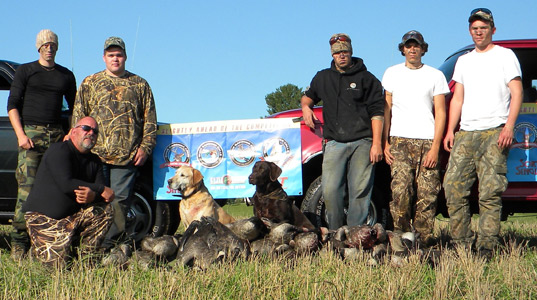
This successful hunt can be attributed to a call from a relative.
There is situation in which loud, aggressive calling can work wonders: Say a flock of ten geese comes into your spread and your crew drops five birds. IMMEDIATELY jump on your call, giving them comeback and feeding calls. More often than not, you will be able to swing the remainder of the flock around for another shot. This is a great trick that will usually only work for a short period of time during the early season.
Paying attention to these simple tips and tricks are a good start when chasing early season geese, but just remember that their patterns and moods can change on a day to day basis. Being versatile, mobile, able to adapt to each specific situation will help you put more birds in the bag.






